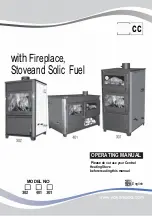
FUEL SUPPLY / INSTALLATION
OIL STORAGE TANKS:
Oil storage tanks made of steel and all connecting
equipment (e.g. filling pipes, and vent pipes) should
comply with B.S. 799 Part 5. Galvanised steel must
not be used. Polyethylene (Plastic) tanks should
comply with OFTEC standard OFS T100 and or
equivalent. Oil should never be stored in translu-
cence plastic containers.
In order to enable sediment and water to be removed
from steel tanks a drain valve must be fitted.
An isolating valve should be fitted at the tank outlet,
in an accessible position so that the oil supply to the
appliance can be shut off if required. This isolating
valve must be of a type suitable for use with oil. (see
Fig.2)
Oil storage tank support must be carried out in accor-
dance with the tank manufacturers recommenda-
tions. Tanks should be located in the most
un-obstructive position possible having taken safety,
filling, maintenance and the need, to provide a head
of oil for the burner into consideration.
FUELS
USE ONLY 28 SECOND VISCOSITY KEROSENE
FUEL OIL TO B.S. 2869 PART 2 CLASS C2 OR
EQUIVALENT.
FUEL SUPPLY LINE
The oil supply line from the oil storage tank to the ap-
pliance should be of an approved and suitable pipe
with a minimum internal diameter of 8mm (5/16”) and
connected to the oil control valve.
Oil supply pipes are normally run in annealed copper
tube complying to EN 1057, it can be obtained in coil
or half hard form for use with bending machines. This
pipe can also be obtained with protective plastic
sheathing applied. Fittings for copper pipe should be
compression of the flared manipulative type to B.S.
864: Part 2 1983. Steel pipes complying with B.S.
1387: 1985, if used, must be protected from corro-
sion. Galvanised pipe and fittings must not be used.
Screwed joints must only be made with taper threads
complying to B.S. 1740 : Part 1 1971.
Jointing materials must be of types intended for use
with oil fuel. Special petroleum resisting compounds
and PTFE tape are suitable. External pipes should
preferably be run with a continuous rise towards the
direction of flow, so that air can be vented off. It is
important to avoid high points which could cause air
locks. Exposed lengths of oil supply pipe must be
properly supported by purpose made clips securely
fixed in place. Metal clips formed so as to hold the
pipe on to a saddle are preferred. Consideration
should be given to avoiding routes which expose the
pipe to severe chilling which could cause freezing of
the oil. Where pipes are buried, they must be pro-
tected from accidental damage. The use of joints un-
derground should be avoided if at all possible. If
joints have to be fitted in pipes laid below ground, ac-
cess to them must be provided.
An oil filter (5 - 10 micron) and a stop valve must be
fitted to the fuel feed line and located near the supply
tank and facilities should be provided to enable it to
be serviced without draining down the oil supply sys-
tem. (See Fig. 2).
At the point where the oil line enters the building, the
oil line must be fitted with an approved remote acting
fire valve which meets the requirements of B.S. 5410
: Part 1, fitted with the appropriate length of capillary.
The temperature rating limit should be 90
o
C. The
heat sensoring phial of the fire valve must be fitted to
the clip provided at the back of the stove. It is ab-
solutely essential that the fire valve is located exter-
nally and is as close as possible to the appliance. For
existing installations where the oil supply is built into
the structure internally, the remote acting fire valve
should be fitted where the oil supply line is first ex-
posed internally. This type of layout is not recom-
mended for new installations.
6
Fig.2
Fig.3
External Wall






































